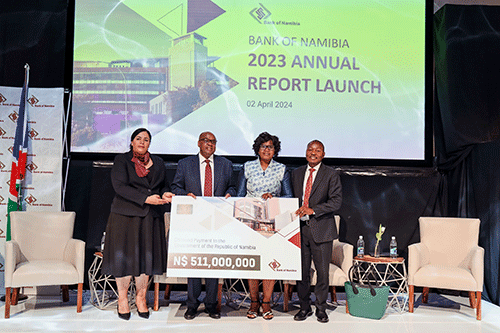Rising food and energy prices are expected to dampen prospects for a stronger recovery in growth in the domestic economy.
This is likely to exacerbate unemployment, poverty, and inequality in the country. Meanwhile, increasing inflationary pressures on the domestic cost of living is a major concern for society’s most vulnerable members, particularly as they are disproportionately affected by unwavering increases in commodity prices.
This was the stark reality shared by Bank of Namibia governor Johannes !Gawaxab late last week, in his presentation on the state of the economy to Public Enterprise CEOs. The 7th Public Enterprise Chief Executive Officers Forum’s Annual General Meeting took place in Oranjemund, //Kharas region.
Despite the escalating risks to the domestic economy !Gawaxab stated the bank continues to forecast positive growth in 2022, fuelled by mineral exploration, diamond production, agriculture, forestry, and fishing
industries.
“Despite challenges such as water supply constraints and higher input costs, the uranium mining sector is expected to grow at a healthy rate in 2023. Finally, growth in metal ores will be supported by increased output from the gold sub-sector, which accounts for the majority of metal ores,” said !Gawaxab.
Meanwhile, domestically, inflation has already started to increase and is projected to rise further during the remainder of 2022, mainly driven by high international prices for crude oil and food items.
!Gawaxab explained that through its monetary policy stance, one of the Bank of Namibia’s primary mandates is to contain inflation and ensure sustainable development. To protect the exchange rate’s peg to the rand and to begin normalising interest rates, the monetary policy committee raised the Repo rate by 25 basis points in February 2022 and another 25 basis points in April 2022.
The governor indicated that this is likely to continue in order to protect the peg and prevent capital flight to other member states of the Common Monetary Area (CMA).
During his presentation, !Gawaxab stated the war in Ukraine is a watershed moment in history that is reshaping geopolitical developments, and as a result, many countries, including Namibia, are facing serious headwinds and downside risks through various channels.
The governor explained that four major developments are dominating the global and domestic economies: the Russia-Ukraine war, a global increase in interest rates, re-emergence of Covid-19, and the threat of another global economic recession. In this regard, the IMF revised global growth for 2022 downward from 4.3% to 3.6% in April of this year, owing largely to the war and supply chain disruptions.
The presentation also covered financial stability in Namibia, exemplified by the banking sector’s performance, citing an adequate capital position in 2021 and early 2022 despite a challenging economic environment.
In this regard, the amendment of the Determination on Policy Changes of Relief measures extended to SMEs was extended to April 2023. The extension was brought about by the challenges that continue to be experienced arising from Covid-19.
!Gawaxab stated that in order to accelerate economic recovery, Namibia must increase the momentum of Covid-19 vaccine uptake in order to achieve herd resistance in the midst of the winter season.
In terms of the country’s economic recovery strategy, he places emphasis on attracting much-needed Foreign Direct Investment that he said should be accompanied by appropriate policies to create a business-friendly environment.
!Gawaxab also urged the implementation of the Diversification Plan developed by Harvard Growth Lab, the finance ministry and the National Planning Commission in key economic sectors.
Finally, !Gawaxab said despite significant global and domestic challenges, Namibians should remain optimistic and capitalise on opportunities brought about by the country’s abundant natural resource endowment (green hydrogen, oil, gold, uranium etc.), which he said will ultimately grow the country’s
wealth.


